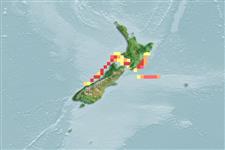Myxini (hagfishes) >
Myxiniformes (Hagfishes) >
Myxinidae (Hagfishes) > Eptatretinae
Etymology: Eptatretus: hepta (Gr.), seven; tretos (Gr.), perforated (i.e., with holes), referring to seven gill apertures on what would later be described as Homea banksii (=E. cirrhatus) [range within genus is 6-14 pairs of gill apertures]. (See ETYFish); poicilus: From the Greek poikilos, mottled or varicolored, referring to its distinctive mottled color pattern. (See ETYFish).
Environment: milieu / climate zone / depth range / distribution range
Ecology
Marine; bathydemersal; depth range 110 - 842 m (Ref. 115309). Deep-water
Western Pacific: endemic to the Three Kings Islands of New Zealand (Ref. 115309).
Size / Weight / Age
Maturity: Lm ? range ? - ? cm
Max length : 92.1 cm TL male/unsexed; (Ref. 115309)
Short description
Identification keys | Morphology | Morphometrics
Diagnosis: 8 pairs of gill pouches and gill openings, strongly mottled with pale brown, dark brown, and white-beige body colour, 3/3 multicusps, and 77–86 total slime pores; distinguished from all other myxinids except Eptatretus gomoni, Eptatretus luzonicus, Eptatretus indrambaryai, Eptatretus okinoseanus, and Eptatretus octatrema by having 8 gill pouches associated with 8 branchial openings; differs from those 5 Indo-Pacific species by having 3-cusp multicusps on the posterior row of teeth (versus 2-cusp multicusps). (Ref. 115309).
From observations of baited videos, this hagfish is much less active feeding on the bait, and is less inclined to produce slime; possible that the colour pattern of this species offers good camouflage in deep-sea reefs or habitats
composed of sand patches over hard substrate, which was also abundant in the Three Kings area (Ref. 115309).
Life cycle and mating behavior
Maturities | Reproduction | Spawnings | Egg(s) | Fecundities | Larvae
Zintzen, V., C.D. Roberts, L. Shepherd, A.L. Stewart, C.D. Struther, M.J. Anderson, M. McVeagh, M. Noren and B. Fernholm, 2015. Review and phylogeny of the New Zealand hagfishes (Myxiniformes: Myxinidae), with description of three new species. Zool. J. Linnean Soc. 174:363-393. (Ref. 115309)
IUCN Red List Status (Ref. 130435)
Threat to humans
Harmless
Human uses
Tools
Special reports
Download XML
Internet sources
Estimates based on models
Phylogenetic diversity index (Ref.
82804): PD
50 = 0.5000 [Uniqueness, from 0.5 = low to 2.0 = high].
Bayesian length-weight: a=0.00204 (0.00092 - 0.00452), b=2.93 (2.73 - 3.13), in cm total length, based on LWR estimates for this (Sub)family-body shape (Ref.
93245).
Trophic level (Ref.
69278): 4.4 ±0.7 se; based on size and trophs of closest relatives
Resilience (Ref.
120179): Low, minimum population doubling time 4.5 - 14 years (Preliminary K or Fecundity.).
Fishing Vulnerability (Ref.
59153): High vulnerability (57 of 100).
